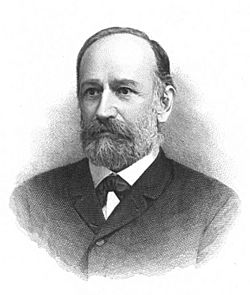Josef Stefan facts for kids
Quick facts for kids
Josef Stefan
|
|
|---|---|

Josef Stefan (1835–1893)
|
|
| Born | 24 March 1835 St. Peter (today in Klagenfurt), Austrian Empire
|
| Died | 7 January 1893 (aged 57) |
| Citizenship | Austrian Empire |
| Alma mater | University of Vienna |
| Known for | Stefan–Boltzmann law Stefan–Boltzmann constant σ Stefan problem Stefan's equation Stefan's formula Stefan flow Stefan number Maxwell–Stefan diffusion |
| Awards | Lieben Prize (1865) |
| Scientific career | |
| Fields | Physicist |
| Institutions | University of Vienna |
| Academic advisors | Andreas von Ettingshausen |
| Doctoral students | Ludwig Boltzmann Marian Smoluchowski Johann Josef Loschmidt |
Josef Stefan (born March 24, 1835 – died January 7, 1893) was a brilliant physicist, mathematician, and even a poet from the Austrian Empire. He was a Slovene person from the region of Carinthia. Stefan is famous for his important discoveries in physics, especially about how heat and light work.
Contents
Early Life and Education
Josef Stefan was born in a small village called St. Peter. This village is now part of Klagenfurt in Austria. His parents, Aleš and Marija Stefan, were both Slovenes. They were a humble family. His father worked in a mill, and his mother was a maid.
Stefan went to elementary school in Klagenfurt. He was very talented and smart. Because of his skills, his teachers suggested he continue his education. So, in 1845, he went to a high school called Klagenfurt Lyceum.
When he was 13, in 1848, there were big revolutions across Europe. This time inspired him to support Slovene writing and culture.
University Studies
After finishing high school at the top of his class, Stefan thought about becoming a monk. But his strong interest in physics won out. In 1853, he moved to Vienna to study mathematics and physics at the University of Vienna.
One of his physics teachers in high school was Karel Robida. Robida wrote the first physics textbook in the Slovene language. In 1858, Stefan earned his qualification to teach mathematical physics at the University of Vienna. During his time as a student, he also wrote and published many poems in Slovene.
Career and Achievements
Josef Stefan became a physics professor at the University of Vienna. In 1866, he became the Director of the Physical Institute. He was also the Vice-President of the Vienna Academy of Sciences. He was a member of many other scientific groups across Europe. Stefan passed away in Vienna, Austria-Hungary. A physicist named Janez Strnad has studied Stefan's life and work in great detail.
Stefan's Scientific Work
Stefan wrote almost 80 scientific papers. Most of these were published in the Bulletins of the Vienna Academy of Sciences. He is most famous for creating Stefan's law in 1879.
Stefan's Law Explained
Stefan's law is a rule in physics. It says that the total radiation (energy given off as heat or light) from a perfect black body is related to its temperature. A black body is an ideal object that absorbs all radiation that hits it. Stefan found that the energy it radiates is proportional to the fourth power of its temperature. This means if you double the temperature, the energy radiated increases 16 times (2 x 2 x 2 x 2 = 16)!
He figured out this law by looking at measurements from French physicists Dulong and Petit. This law applies to any ideal object that is absorbing and emitting radiation. In 1884, Stefan's student, Ludwig Boltzmann, expanded this law. He showed it also applies to "grey bodies," which are not perfect black bodies. That's why it's now called the Stefan–Boltzmann law. This law is the only physical law named after a Slovene physicist.
Using his law, Stefan was able to figure out the temperature of the Sun's surface. He calculated it to be about 5,430 degrees Celsius. This was the first time anyone had a reasonable estimate for the Sun's temperature.
Other Important Discoveries
Stefan also made the first measurements of how well gases conduct heat. He studied evaporation, which is when a liquid turns into a gas. He also researched diffusion, which is how particles spread out. And he looked into how heat moves through fluids like liquids and gases.
For his work on optics (the study of light), the University of Vienna gave him the Lieben Prize. Because of his early work on evaporation and diffusion rates, the flow of gas from a droplet or particle caused by evaporation is now called the Stefan flow.
Electromagnetism and Mathematics
Stefan also made important contributions to electromagnetism. These are the rules that describe how electricity and magnetism work together. He was one of the first physicists in Europe to fully understand Maxwell's electromagnetic theory. He even corrected one of Maxwell's calculations. He also studied the skin effect. This is a phenomenon where high-frequency electric current flows more on the surface of a conductor than inside it.
In mathematics, the Stefan problems are well known. These problems deal with situations where a boundary moves. For example, Stefan solved this problem when he calculated how quickly a layer of ice grows on water. This calculation is known as Stefan's equation.
Eponymous Terms
Many scientific concepts are named after Josef Stefan because of his important work. These include:
- Stefan–Boltzmann law
- Stefan–Boltzmann constant σ
- Stefan problem
- Stefan's equation
- Stefan's formula
- Stefan flow
- Stefan number
- Stefan's force
The Jožef Stefan Institute, a famous research institute, was also named after him.
See also
 In Spanish: Josef Stefan para niños
In Spanish: Josef Stefan para niños

